
The Appalachian Mountains, often called the Appalachians, are a system of mountains in eastern to northeastern North America. The Appalachians first formed roughly 480 million years ago during the Ordovician Period. They once reached elevations similar to those of the Alps and the Rocky Mountains before experiencing natural erosion. The Appalachian chain is a barrier to east–west travel, as it forms a series of alternating ridgelines and valleys oriented in opposition to most highways and railroads running east–west.

Ptelea trifoliata, commonly known as common hoptree, wafer ash, stinking ash, and skunk bush, is a species of flowering plant in the citrus family (Rutaceae). It is native to North America, where it is found in Canada, Mexico, and the United States. It is a deciduous shrub or tree, with alternate, trifoliate leaves.
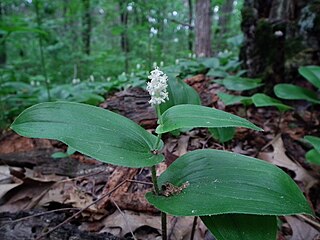
Maianthemum canadense is an understory perennial flowering plant, native to Canada and the northeastern United States, from Yukon and British Columbia east to Newfoundland, into St. Pierre and Miquelon. It can be found growing in both coniferous and deciduous forests. The plant appears in two forms, either as a single leaf rising from the ground with no fruiting structures or as a flowering/fruiting stem with 2-3 leaves. Flowering shoots have clusters of 12–25 starry-shaped, white flowers held above the leaves.

Rubus leucodermis, also called whitebark raspberry or blackcap raspberry, is a species of Rubus native to western North America.

Tiarella, the foamflowers, is a genus of flowering plants in the family Saxifragaceae. The generic name Tiarella means "little turban", which suggests the shape of the seed capsules. Worldwide there are seven species, one each in eastern Asia and western North America, plus five species in eastern North America. As of October 2022, the taxonomy of Tiarella in eastern North America is in flux.

North American Atlantic Region is a floristic region within the Holarctic Kingdom identified by Armen Takhtajan and Robert F. Thorne, spanning from the Atlantic and Gulf coasts to the Great Plains and comprising a major part of the United States and southeastern portions of Canada. It is bordered by the Circumboreal floristic region in the north, by the Rocky Mountain and Madrean floristic regions in the west and by the Caribbean floristic region of the Neotropical Kingdom in the south of Florida. The flora of the region comprises two endemic monotypic families, Hydrastidaceae and Leitneriaceae, and is characterized by about a hundred of endemic genera. The degree of species endemism is very high, many species are Tertiary relicts, which survived the Wisconsin glaciation and are now concentrated in the Appalachians and the Ozarks. A number of genera are shared only with the Canadian floristic province of the Circumboreal region. Moreover, as has long been noted, a large number of relict genera are shared with the relatively distant Eastern Asiatic Region and sometimes Southeast Asia. R. F. Thorne counted at least 74 genera restricted to eastern North America and Asia. The fossil record indicates that during the Tertiary period a warm temperate zone extended across much of the Northern Hemisphere, linking America to Asia.
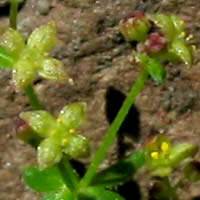
Galium nuttallii is a species of flowering plant in the coffee family known by the common names San Diego bedstraw and climbing bedstraw. It is native to the coast and coastal Peninsular and western Transverse Ranges of southern California and Baja California, where it is a member of chaparral and pine woodland plant communities. It is also found on the Channel Islands and on the mainland as far north as Santa Barbara County
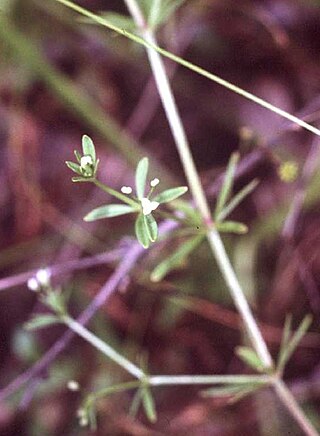
Galium trifidum is a species of flowering plant in the coffee family, known by the common name three-petal bedstraw. It grows widespread in the arctic, temperate and subtropical regions of the Northern Hemisphere: northern and central Asia, northern and eastern Europe and much of North America.
Bradburia is a North American genus of flowering plants in the family Asteraceae, native to the southern United States.

Pycnanthemum is a genus of herbaceous plants in the mint family (Lamiaceae). Species in this genus are often referred to as "mountain mints" and they often have a minty or thyme-like aroma when crushed. All species of Pycnanthemum are native to the United States and Canada. The center of diversity for the genus is North Carolina with 13 of the 20 species having been collected therein. Nineteen of the 20 species of Pycnanthemum occur in the Eastern US and Canada, and one disjunct species occurs in California and Oregon.

Galium circaezans, common name licorice bedstraw or wild licorice, is a plant species in the family Rubiaceae. It is native to the eastern half of the United States from the Great Plains to the Atlantic, plus Quebec and Ontario. There are also a few isolated populations in Washington state, probably adventive.
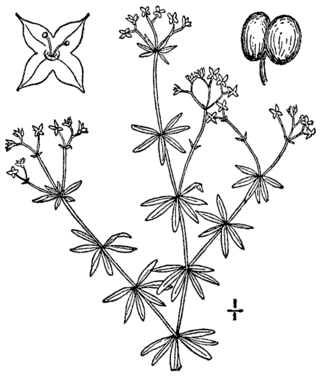
Galium concinnum, the shining bedstraw, is a herbaceous perennial plant species in the Rubiaceae family. It is native to the Midwestern United States and central Canada, especially the Great Lakes Region and the Valleys of the Ohio, lower Missouri, and upper Mississippi Rivers. It is commonly found in deciduous forests and forest edges. It grows low to the ground in natural habitats. Although it is not an invasive species, it can be very weedy. It is typically not cultivated.

Galium virgatum, common name southwestern bedstraw, is a North American species of plants in the Rubiaceae. It is native to the south-central part of the United States, primarily in the southern Great Plains from Texas to Missouri, but with scattered populations as far east as South Carolina.
Aphanostephus riddellii is a North American species of flowering plants in the family Asteraceae, with the common name Riddell's lazydaisy. It is native to the southwestern and south-central United States, as well as to the state of Coahuila in northern Mexico.
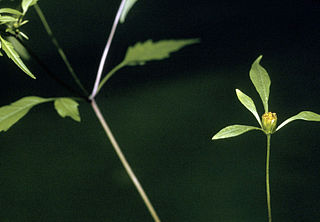
Bidens discoidea, the small beggarticks, is a North American species of flowering plant in the family Asteraceae. It is widespread across eastern Canada and the eastern and central United States, from Nova Scotia west to Minnesota, south to Florida and Texas.
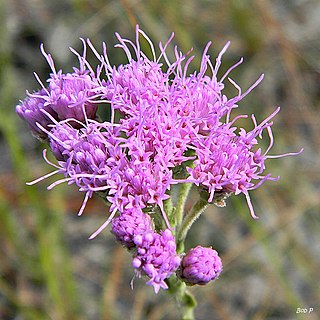
Carphephorus corymbosus, the Florida paintbrush or coastal plain chaffhead, is a species of North American plants in the family Asteraceae. They are native to the southeastern United States in the States of Florida, Georgia, and South Carolina.

Erigeron vernus is a North American species of flowering plant in the family Asteraceae known by the common name early white-top fleabane. It is native to the southeastern United States from Virginia to Louisiana.

Solidago curtisii, commonly called Curtis' goldenrod and mountain decumbent goldenrod, is a North American species of flowering plants in the family Asteraceae. It is the eastern part of the United States from Pennsylvania to Mississippi and Alabama, primarily in the southern Appalachian Mountains.
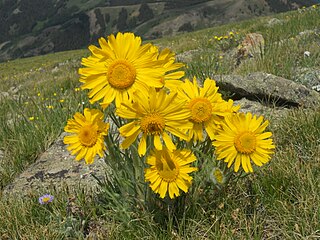
Hymenoxys grandiflora is a North American species of flowering plant in the daisy family known by the common names graylocks four-nerve daisy, graylocks rubberweed, or old man of the mountain. It is native to high elevations in the Rocky Mountains of the western United States.
The Eastern Temperate Forests is a Level I ecoregion of North America designated by the Commission for Environmental Cooperation (CEC) in its North American Environmental Atlas. The region covers much of the Eastern and Midwestern United States, the U.S. Interior Highlands, and parts of Ontario, Quebec, and the Maritimes.



















